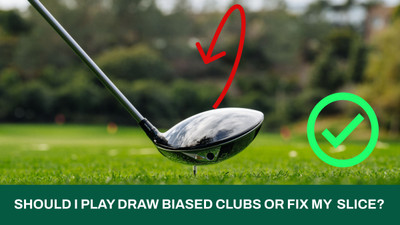Should I Play Draw Biased Clubs Or Fix My Slice?
Posted by GolfBox on 7th Mar 2024
The unfortunate reality for someone afflicted with a chronic slice is golf can be a frustrating game. Playing down the right side of the fairway, finding trouble, losing balls and pencilling a snowman-filled scorecard is the unfortunate lived experience of a slicer.
The dreaded left-to-right shot shape (for a RH golfer) of a slice has its origins in an in-to-out swing path and/or an open club face at impact.
Fixing or mitigating a slice is readily achievable, but it leads to one of modern golf’s great quandaries: is it best to cure the swing flaw with lessons, or mask the symptoms with draw-biased equipment?
THE GET LESSONS ARGUMENT

Assistance from a swing coach will stop a slice at its source. In the long term, this can be more beneficial than simply relying on draw-biased clubs to straighten out your game.
A major advantage of improving your technique rather than playing draw-biased equipment, is that you’ll be able to shape the ball both ways. And having the ability to work the ball both ways will vastly increase the range of shots in your repertoire.
A professional will identify the specific swing flaw that is causing a slice and recommend drills to correct your technique to straighten up shots. The kicker, however, is that understanding the reason you slice is one thing; being able to change an ingrained swing flaw is an entirely different proposition.
Rerouting a swing path to kill a slice is major surgery and a lesson is only as valuable as the practice undertaken to entrench the requisite swing changes.
However, some swing flaws can’t be fixed because of a flexibility issue or other physical constraints. If you’re short on time, talent or tractability, draw-biased clubs may be your best hope of taming a slice.
WHY DRAW BIASED EQUIPMENT WORKS

Picture this. A golfer hits slice after slice on the range until a playing partner decides enough is enough.
“Try my draw-biased driver and see what you think,” the playing partner exclaims.
Suddenly, instead of horrendous banana ball after banana ball, it’s an absolute stripe show. The change is remarkable and instantaneous. Long, straight drives with a hint of draw that works the ball back to the middle. And another thing. The drives are travelling at least 20m further.
But rather than gushing about it being the miracle club they’ve been waiting for all these years, the player hands back the driver and mumbles about wanting to “fix” their swing properly rather than leaning on the obvious advantage the draw-biased driver provided.
Sounds insane, right? While there’s nothing wrong with working on a swing to stop a slice, sometimes the solution is in plain sight and staring you right in the face.
However, the reality is many golfers dismiss draw-biased clubs as a viable solution to their slice-induced foibles on the golf course.
There is a well-known saying summarising how to select the right golf clubs and it’s dead simple to understand: “play what works”.
Despite all the golfing pedants who reject draw-biased clubs in favour of the “get lessons” narrative, the facts are clear. Draw-biased clubs will straighten up a slice.
If it works, why wouldn’t you just go with it?
HOW DRAW-BIASED CLUBS WORK

Draw-biased clubs feature a centre of gravity that is closer to the heel than a neutrally balanced club.
Club designers shift the weight around internally to create a draw bias, where a greater proportion of the face will result in balls launching with draw spin. With the CG closer to the shaft, it also promotes a quicker face rotation that helps square up the club face at impact.
Some draw-biased clubs also feature a face that sits slightly closed at address.
Draw-biased equipment always works better at correcting a slice if a golfer’s swing path is fairly neutral. In that scenario, an open club face will be the reason for the slice, rather than a pronounced “over the top” swing path.
A draw-biased club will help shut the face quicker at impact, straightening up a slice.
However, if a swing path is “over the top”, draw-biased clubs can help reduce the severity of a slice but won’t eradicate it completely.
WHY MORE GOLFERS SHOULD PLAY A DRAW-BIASED DRIVER

While it’s plain to see that the vast majority of golfers are fighting a slice, it’s remarkable that draw-biased clubs don’t feature in more player’s bags.
Whether it’s because of pride or ego, golfers appear reluctant to play a draw-biased driver. But interestingly, when the subjectiveness of swing data is involved in the custom club fitting process, draw-biased drivers are recommended half the time.
The small tweak to the centre of gravity in a draw-biased club can make a big difference. Not only will it straighten up a slice, but a draw produces more distance, roll and satisfaction.
Are draw-biased clubs the best kept secret in golf? While lessons will always be an option, it would seem so.
They will eliminate the “big right miss” instantaneously and are a simple fix for golfers trying rid themselves of a nasty slice.
2024 DRAW-BIASED DRIVERS
- Callaway Paradym Ai Smoke MAX D
- TaylorMade Qi10 MAX
- Cobra Darkspeed MAX
- PING G430 SFT
- Titleist TSR3
- Srixon ZX5 MKII
- Mizuno ST-X 230
- Cleveland Launcher XL2 Draw

